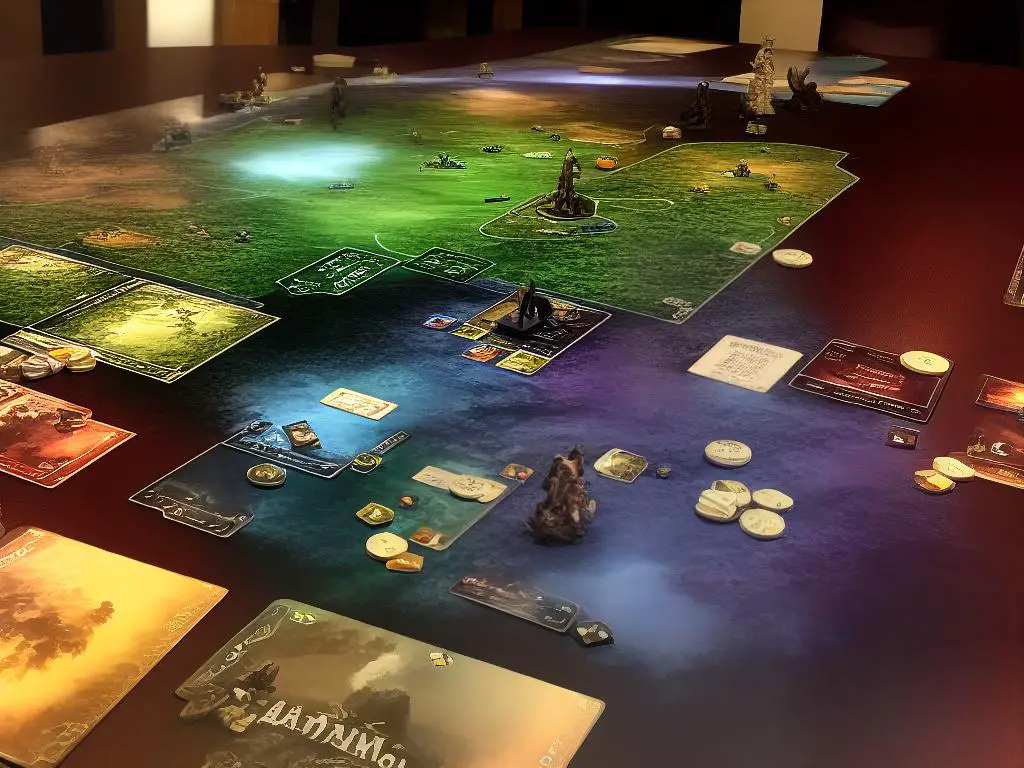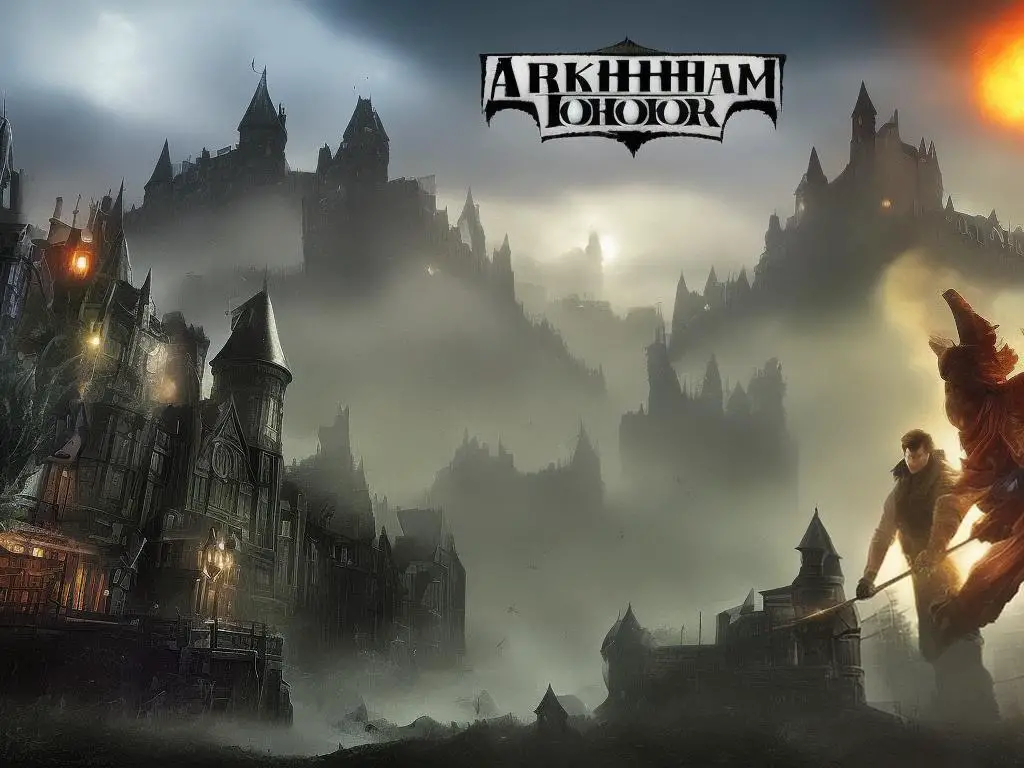Welcome to the chilling environ of Arkham Horror, a love-tinged letter to the cosmic horror of H.P Lovecraft. Envisioned as an in-depth board game, Arkham Horror plunges users into an adrenaline-soaked world filled with creatures of the night, ancient curses, and a small band of investigators eager to save humanity. Whether you’re a novice board gamer or a seasoned aficionado, this essay offers a closer look at the Arkham Horror phenomenon, its origins, gameplay, strategic play, and cultural significance. Open the gateway to this arcane New England town and gear up for a thrilling journey through the surreal and terrifying.
Understanding the Basics of Arkham Horror
Understanding the Basics of Arkham Horror
Arkham Horror is a cooperative adventure board game inspired by the horror writings of H.P. Lovecraft, particularly the Cthulhu Mythos. First published in 1987 by Chaosium and later revitalized by Fantasy Flight Games in 2005, Arkham Horror places the players in the role of investigators exploring the haunted streets of Lovecraft’s fictional city of Arkham, Massachusetts.
Main Objective
In Arkham Horror, the game’s main objective is to prevent the awakening of an Ancient One, a cosmic entity with unstoppable power that would usher in the end of the world. Players must work together to seal away these cosmic horrors by closing interdimensional gates appearing throughout the city and fend off monsters that seep through these portals.
Gameplay and Rules
Gameplay in Arkham Horror revolves around the investigators’ exploration of Arkham and its surroundings. Each turn comprises of three phases: Upkeep, Movement, and Encounter. During the Upkeep Phase, players adjust their stats and abilities, and renew limited-use items. In the Movement Phase, they navigate Arkham city, while the Encounter Phase engages players in battling monsters or interacting with the city’s locales.
Each investigator has separate skills, like luck, lore, will and strength, which can be adjusted to face the particular challenges each turn. These skills play crucial roles during encounters, combat, and skill checks.
Key Elements: Monsters, Gate Cards, Investigators
Players encounter various types of monsters during the game, each with different combat strengths and abilities. Monsters must be evaded or dealt with to ensure the safety of the players and the city. If too many monsters overrun Arkham, the Ancient One awakens, pushing players into a final, desperate battle.
Gate Cards are another important factor. These cards represent the interdimensional gates that the investigators must close. Each card corresponds to a location in Arkham, showing where a gate has opened. Gates contribute to the Ancient One’s awakening; thus, players must prioritize closing them.
The Investigators, controlled by the players, each have unique abilities and a specific amount of health and sanity. Investigators also have access to a variety of items, spells, allies, and unique player abilities that can aid them in their adventure.
Arkham Horror, a board game renowned for its intricate narrative and cooperative style of play, invites participants into a world of high-stakes strategy and story-driven encounters. Its complexity and challenge lie in the vast array of choices players must make, with each decision potentially deciding the fate of the world in facing the terror of the Ancient Ones.

The History and Evolution of Arkham Horror
The Birth of Arkham Horror
Making its debut in 1987, Arkham Horror has since grown to become one of the foremost thematic board games globally. Originally published by Chaosium, a highly respected company in the realm of role-playing games, Richard Launius designed Arkham Horror to offer an immersive, team-oriented adventure that would transport players into the unsettling world created by renowned American horror and weird fiction author, H.P. Lovecraft.
In its original incarnation, players assumed the roles of investigators in the ominous town of Arkham, Massachusetts. They faced the monumental task of preventing an Ancient One, a nightmarish and imposing entity from Lovecraft’s alien dimensions, from awakening. Success relied upon sealing a certain number of supernatural gates leading to alien worlds before the Ancient One had the chance to appear.
The Arrival of the Second Edition
Fast forward to 2005, the game was revamped, redesigned and published by Fantasy Flight Games under the guidance of co-designers Richard Launius and Kevin Wilson. The second edition of Arkham Horror did more than just reprint the original game, it expanded on it in ways that only served to enhance the gameplay experience. The game’s success marked the beginning of the Arkham Horror Files, a series of games based on Lovecraft’s universe.
With the second edition, Arkham Horror’s board became modular, composed of numerous tiles that could be rearranged each game to create a different gaming experience each time. New mechanics were added, such as the Doom Track and Terror Level, to increase the tension, suspense, and strategic requirements of the game. More investigators were introduced, and each was given a unique backstory and set of abilities.
The game also introduced the concept of expansions, which addressed many player suggestions and demand for more content. The Dunwich Horror, the first expansion for the game, introduced new locations, investigators, and Ancient Ones. Subsequent expansions like Kingsport Horror and Innsmouth Horror followed the same path, but each brought its own distinctive elements and mechanics into play.
The Third Edition
In 2018, Fantasy Flight Games released a third edition of Arkham Horror. The newest version of the game brought about significant changes to both its mechanics and storyline. Focusing more on narrative gameplay, Arkham Horror third edition moved from a modular board to a variable one that changes based on the scenario. The game also integrated a card-driven approach, where story scenarios are carried out through individual cards, allowing for greater variability and narrative depth.
The game’s thematics underwent a facelift as well, now featuring more vibrant and detailed artwork, and investigators now looked more dynamic and expressive. Even with its more complex rules and mechanics, the third edition remained true to the spirit of Arkham Horror, providing that Lovecraftian horror and suspense that its players have grown to love over the years.
Overall, the transformation of Arkham Horror from its initial inception in 1987 to the present day showcases its enduring popularity. This board game’s immense appeal stems from its fusion of cooperative gameplay, demanding mechanics, potent storyline, and immersive theme, which all contribute to its esteemed position in the world of modern board games. The game’s continued success is also ensured by the unceasing endeavours of its creators to improve and build upon the game, guaranteeing that Arkham Horror remains an evolving and vibrant board game for years to come.

Exploring the World of Arkham Horror
Providing a short insight into Arkham Horror, it serves as a captivating board game, created for 1-8 participants. The game borrows its setting from the fantastical city of Arkham, derived from the literary works of H.P. Lovecraft and his mythos series specifically. The essence of Lovecraft’s characteristic cosmic horror is cleverly incorporated into the game, casting the players in a scenario where they must face down age-old, supernatural terrors that pose a risk to the city and the world at large.
Understanding the Setting
In the universe of Arkham Horror, the eponymous city exists as a rather bleak and foreboding place in 1920s Massachusetts. The mysteries and perils of Arkham extend well beyond the norm, with otherworldly creatures lurking in the shadows and malignant forces seeking to spread chaos and despair at every turn.
Key Locations in the Game
Many of the game’s mechanics and challenges revolve around iconic locations within the city. Some of the notable sites included in the game are as follows:
- Miskatonic University: A renowned institution of higher learning, it is also a hotbed for paranormal activities. Various faculty members are deeply engaged with investigations into the supernatural, holding key clues that may assist the players in their quest.
- The Witch House: Known to be a place of great spiritual power, the Witch House is famous for its seething dark history of witchcraft and atrocious rituals. The game’s players have to visit this ominous house to gather clues and encounters that may come in handy for their survival.
- Arkham Asylum: This dark and gloomy mental institution serves as the city’s line of defense against the untold horrors unraveling in Arkham. In the game, players can receive psychological treatment here to recover their sanity, a crucial aspect to keep their characters from being consumed by the horrors they face.
Interactions with Locations
Each location in the game has its distinctive purpose and potential encounters. Players may uncover vital clues, acquire useful items, or run into dangerous scenarios at each site. The interaction of players with the city’s locations plays a pivotal role in the narrative and mechanics of the game, pushing forward the storyline while keeping the stakes dangerously high.
The design of the game heavily emphasizes atmosphere and storytelling, with the locations in Arkham serving to heighten a sense of dread and impending doom. Every venture into a new section of the city can lead to untold terrors or valuable resources, and it is this uncertainty that grants Arkham Horror its compelling allure.
Step into Arkham and Lovecraft’s Universe
In the thrilling board game, Arkham Horror, players enter the city of Arkham—an environment heavily inspired by Lovecraft’s narrative of a world teetering on the brink of chaos and unseen by its unsuspecting inhabitants. The various locations in the city signify different Lovecraft’s stories, in which the thin veil separating reality and the realm of ancient horrors is dangerously breached.
The chilling elements of Lovecraft’s Mythos are expertly integrated into every segment of Arkham Horror. Their menacing influence steadily permeates through every hidden corner in the city. By immersing players into Lovecraft’s unnerving universe of horror and suspense, the game stands as a true homage to his literary genius.
Strategies and Tactics for Winning Arkham Horror
Delve into Arkham Horror: A Cooperative Board Game
Arkham Horror is a cooperative strategy board game that is set in the unsettling world of H.P. Lovecraft’s Cthulhu Mythos. The players take on the roles of investigators in the town of Arkham and cooperatively strive towards a common goal—to prevent the awakening of a malevolent entity known as the ‘Great Old One’. This is achieved by teaming together to close interdimensional gates that spill monstrous creatures into Arkham. Victory is on the horizon when enough gates are closed, or if the players valiantly defeat the Great Old One, should it stir awake during gameplay.
Selecting the Right Investigators
In Arkham Horror, each player chooses a character with unique abilities, aptly named investigators. The game provides a wide variety of investigators, each with different strengths. It is essential to build a team with balanced skills.
For instance, investigators with high “Sneak” and “Speed” ratings are ideal for avoiding combat with monsters and moving around the Arkham board quickly. Investigators with a high “Lore” rating are proficient in casting spells, which are powerful tools for gate closing and combat. Characters with high “Fight” and “Will” ratings are great for engaging enemies in combat. It is recommended that each team has a well-balanced mix of these abilities.
Player Coordination is Key
As a cooperative game, Arkham Horror requires strategic coordination among players. Communication and joint decision-making are vital for facing the increasing number of monsters and closing the gates.
Players can coordinate in various ways. One way is by assigning roles based on an investigator’s strengths. For instance, players with investigators who excel in combat can focus on killing monsters, while others with high ‘lore’ can concentrate on closing gates.
Another way is by sharing resources. Players are encouraged to exchange items, spells, and clues, allowing them to maximize their investigators’ potential. By planning and strategizing together, players have a higher chance of winning the game.
Effective Ways to Close Gates
The primary objective of Arkham Horror is to close gates. Closing gates requires players to explore other dimensions known as ‘Other Worlds.’ Investigators can enter an open gate, which transports them to ‘Other Worlds’ where they must survive for at least two turns before returning to Arkham to close the gate.
Ensure your investigator has suitable equipment, like clues and spells, before entering a gate. Clues can be used to close gates instantly, while “Gate-closing” spells allow players to close gates from a distance.
Conclusion
To emerge victorious in a round of Arkham Horror, your team of investigators must practice careful selection, effective coordination, and efficiently close interdimensional portals. By mastering these crucial elements, you are well on your way to deploying advanced strategies that can dramatically enhance your chances of thwarting the Great Old One.

The Influence and Impact of Arkham Horror
Impact on Popular Culture and the Board Game Universe
Since its release by Fantasy Flight Games in 2005, Arkham Horror has carved out a significant niche for itself in the world of board games and popular culture. It has become a mainstay at gaming gatherings and consistently high-performing title in hobby shops worldwide. Its unique blend of dark, eerie themes and cooperative gaming experience has inspired a new generation of game designers and fueled the creation of new board games.
The Arkham Horror Files Universe, which includes popular spinoffs like Eldritch Horror and Mansions of Madness, is perfect proof of this influence. The games bear the unmistakable stamp of the Lovecraftian horror theme and intricate gameplay that are the hallmarks of Arkham Horror.
The influence of Arkham Horror reaches beyond the realm of gaming. The game, built upon H.P. Lovecraft’s legendary writings, has left a lasting impression on movies, TV shows, novels, and more. Its dark, brooding atmosphere and compelling narrative quality have helped to shape the popular perception of cosmic horror.
Player Testimonials: A Game that Reshapes Reality
Players over the years have borne testimony to the profound impact Arkham Horror has had on them. For many, it is not just a board game but an immersive, shared storytelling experience. It’s distinctive in that it demands cooperation, planning, and strategy from the players to overcome the prevailing cosmic threats.
Arkham Horror has not only molded how players interpret the horror genre; it has also shaped their expectations from board games. The game’s depth and complexity, coupled with its provocative mythos, place it above a mere pastime and elevate it to a captivating shared experience that stimulates the imagination of its players.
A prominent feature mentioned in multiple player testimonials is the sense of camaraderie the game engenders. Experienced in groups, the collective decision-making and shared victories and losses in Arkham Horror lead to a sense of unity and mutual dependence rare in board games. The emotional journey players embark on together cements the game’s position as an inspiring social experience.
Horror Board Game Landscape: From Arkham and Beyond
The success and influence of Arkham Horror is indicative of the emergence and acceptance of horror themes in board gaming. Comparable games, like Pandemic and Dead of Winter, echo similar mechanics of cooperation and storytelling.
While Arkham Horror wasn’t the first game to tackle horror themes, it managed to masterfully blend an intriguing narrative with innovative gameplay, something its contemporaries have sought to replicate.
The game’s influence isn’t limited to horror board games. Its emphasis on cooperative gameplay, character development, and ongoing narrative can be found in an array of contemporary board games across genres. The game has inspired a design trend that values storytelling and character development as much as mechanism and competitiveness.
In conclusion, Arkham Horror’s legacy is two-fold. On one hand, it has influenced the design and story of other board games, encouraging them to include more complex narratives and polished mechanics. On the other, it has impacted players’ perception of what board games can be, transforming them from simple leisure activities into interactive storytelling and world-building experiences.

Arkham Horror is not just a game, but an exhilarating experience that plunges you into a disturbing reality dictated by unspeakable horrors and desperate survivors. The mechanics, allies, and fantastic realms of this captivating board game keep your mind alert and your pulse racing. As you plan, react, and ultimately strive for victory, the engrossing narrative of Arkham Horror unfolds beneath, displaying depths of strategy and storytelling that board games rarely achieve. Delving into the world of Arkham Horror is not just about playing a game; it’s about embarking on a journey fraught with danger, complex decisions, and the looming shadow of ancient, cosmic horror. It’s no wonder that its influence continues to ripple across the board game industry, impacting players and designers alike. Embrace the darkness, brave the horror, and be part of the Arkham Horror legend.
